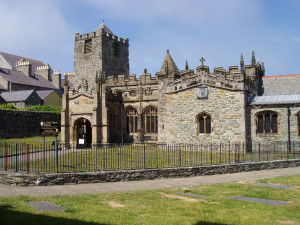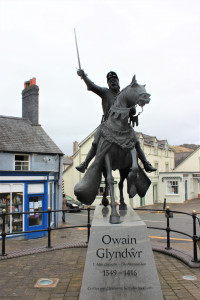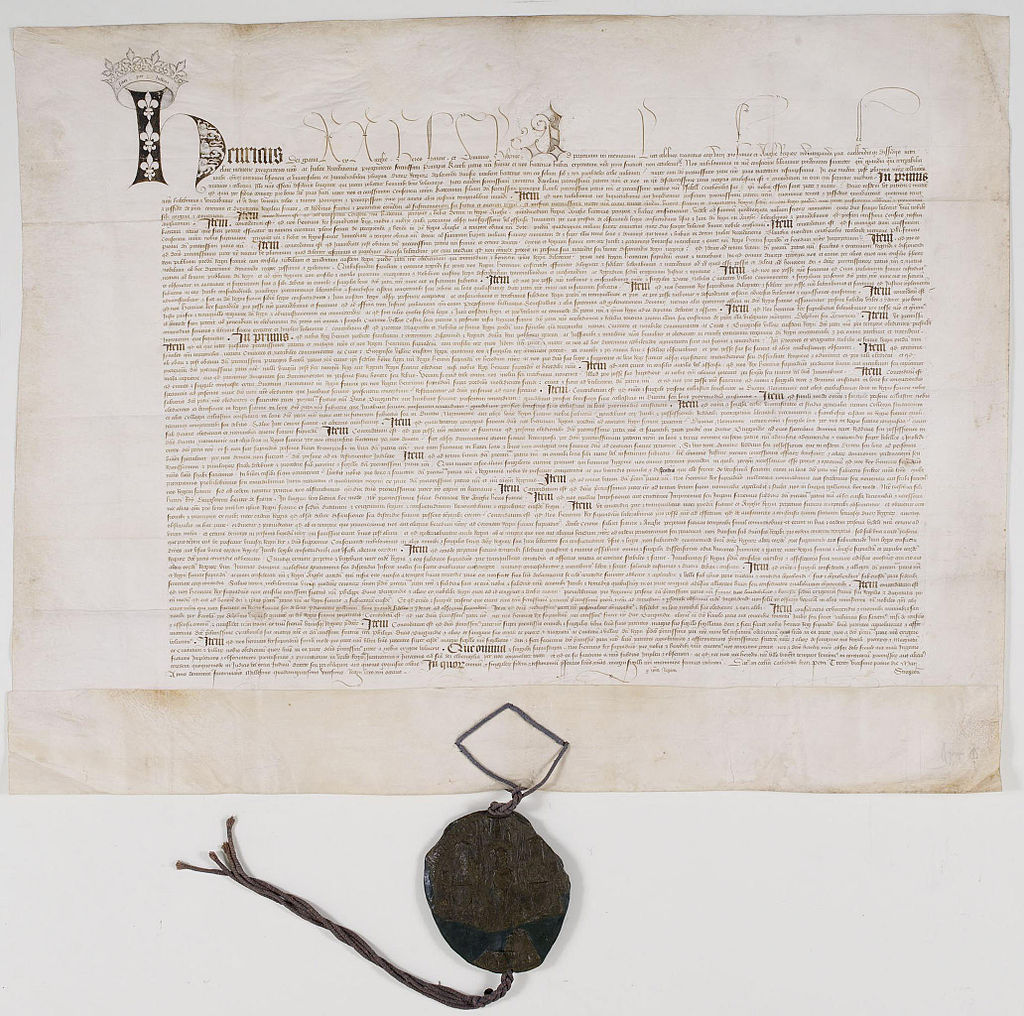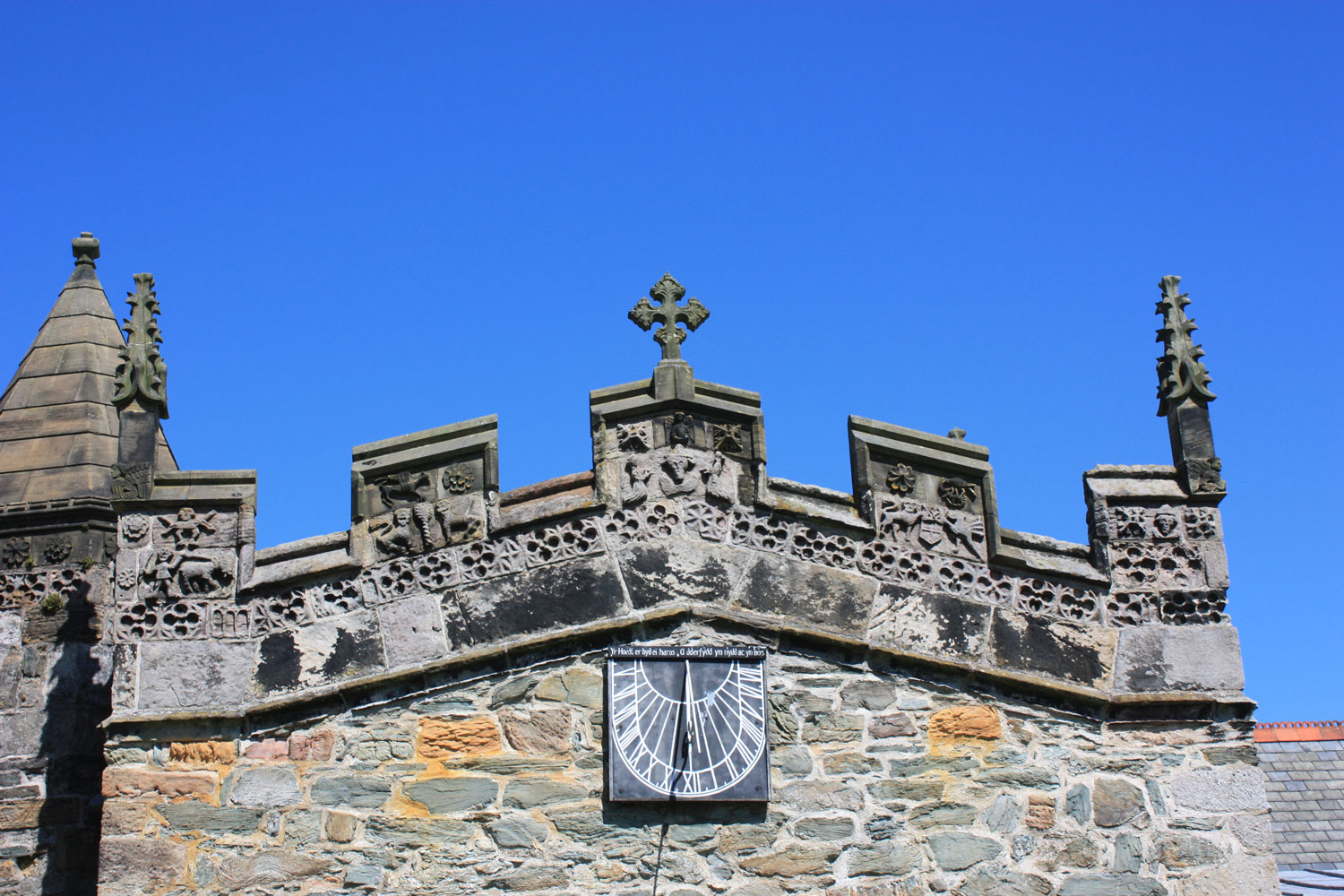Holyhead Hamlet
An Extent of 1352 records Holyhead was still only a hamlet with the church then rebuilding. We have no further information about this building work.
There is, however, evidence of the present building in the churchyard, known as Eglwys y Bedd dating from about this time. See the separate section on Eglwys y Bedd.
Welsh rebellion.
The start of the fifteenth century saw the Owain Glyndŵr rebellion.
Owain Glyndŵr was a Welsh rebel who instigated a fierce and long-running, yet ultimately unsuccessful, war of independence with the aim of ending English rule in Wales during the Late Middle Ages. He was the last native Welshman to hold the title Prince of Wales (Tywysog Cymru).
The failure of the revolt had consequences for St. Cybi’s church. Reference is made to this by Professor A. D. who refers to an 1833 pamphlet, Hanes Owain Glandwr, Blaenor y Cymry mewn Rhyfel, by William Owen, and says “In his pamphlet William Owen stated that in June 1405 an Irish army commanded by Stephen Scope, deputy-lieutenant of Ireland, landed at Holyhead and did great damage in Anglesey. Thousands of local people met them at Rhosmeirch but they were put to flight because there were six times as many Irishmen. The force went on to Beaumaris and recaptured the castle and the town from the Welsh, killing the rebel garrison in the course of the campaign. Many fled to the mountains with their livestock. The Irish left after devastating the whole island; they took the shrine of St Cybi from Holyhead and put it in Christ Church cathedral in Dublin.
“These losses could not but be a blow to the rebels who had previously been in control of Anglesey and the events of 1405 may have led to those of 1406 [when punishments for rebellion were imposed]; according to William Owen the inhabitants had suffered so much from the Irish that they had no choice but to submit and pay fines.”[i]
Professor Carr then deals with some details relating to the fines imposed and then comments “One class which was well represented in the 1406 list was the clergy. Sixteen beneficed clerics submitted and another three were still in rebellion. If the title ‘Offeiriad’ in a personal name indicates a man in priest’s orders there were also fifteen unbeneficed clergy together with four canons of Caergybi, six Franciscan friars from Llan-faes and the archdeacon of Anglesey; two of the canons, the friars and the archdeacon had not submitted. This bears out the argument that the revolt was also a clerical protest.”
We know that Lewelinus ap Rees, clericus, prebend of Caergybi, and Howell Gloss, priest of the adjoining parish of Rhoscolyn, (now part of this Ministry Area) were involved in the Glyndwr rising.
The desecration of St Cybi’s shrine and the removal of his relics to Dublin can be regarded as a deliberate punishment. The shrine was a place of pilgrimage, and, as such, a source of revenue for the church.
Not long after St Cybi’s was again involved in International events. England was, between 1337 and 1453, in conflict with France in what became known as the 100 years War. During this series of conflicts Henry V of England retook much of Normandy turning the province English for the first time in about 200 years. Following this success, in 1420 Henry and King Charles VI of France signed the Treaty of Troyes. By this treaty Henry married Catherine of Valois, Charles’ daughter. When Henry died on 21stOctober 1422 Catherine was in England and the terms of the treaty had not been fully implemented.
To compensate for monies not paid under the treaty the English Parliament granted to Catherine, as Henry’s widow, lands, including the whole of the island of Anglesey, which included the crown’s ecclesiastical patronage on the island, which, in turn, included St Cybi’s.
Jean Tiphaine became a member of the Faculty of Medicine in France in November 1418, after successfully completing his studies at the university of Paris. In 1419 he was ordained a priest. He became physician to Catherine. On 2ndSeptember 1423, as Patron of the church, Catherine presented Jean Tiphaine as Provost of St Cybi’s.
In his capacity as a physician, Jean Tiphaine was involved in the interrogation of Joan of Arc. The records of Joan’s interrogation show “The morrow, the 25th of February, was the first Sunday in Lent. On that day or another, but probably on that day my Lord Bishop sent Jeanne a shad [other records show that Joan became ill on 1stApril 1431]. Having partaken of this fish she had fever and was seized with vomiting. Two masters of arts of the Paris University, both doctors of medicine, Jean Tiphaine and Guillaume Delachambre, assessors in the trial, were summoned by the Earl of Warwick, who said to them: ‘According to what has been told me, Jeanne is sick. I have summoned you to devise measures for her recovery. The King would not for the world have her die a natural death. She is dear to him, for he has bought her dearly; his intent is that she die not, save by the hand of justice, and that she should be burned. Do all that may be necessary, therefore, visit her attentively, and endeavour to restore her.’”
There is no record of when Jean Tiphaine relinquished his Provostship but it was probably in 1427.
The building of the present church.

The south side of St Cybi’s Church. The tower at the western end dates from 1625; the porch, south Aisle and south Transept date from 1520 and the chapel on the right of the photograph dates from 1897. The church is Grade I listed. Part of the 4th century Roman Wall can be seen in the background. The wall is an Ancient Monument.
Between 1480 and 1520 most of the present church was constructed, although part of the chancel pre-dates this work. In 1480 the chancel was rebuilt on old foundations and the north and south transepts were added. In 1500 a north aisle was added, together with the three arches of the crossing and a reconstruction of the chancel arch. In 1520 there was a further extension with the south aisle and arcade, stair turret, south door and south porch being constructed. The carvings on this part of the church are regarded as particularly important.
Break from the Roman Catholic church.
When this work was carried out the church was still part of the Roman Catholic church, but it was only a few years later Henry VIII made the break with Rome and the Church of England came into existence. The churches in Wales, including St Cybi’s, became part of the Church of England and part of the Dissolution. In 1535 St Cybi’s income was worth £48 14s 6d (equivalent to £41,070.74 in 2018) of which £24 (equivalent to £20,229.81 in 2018) was divided among the twelve canons, and in 1553 a Pension List shows 12 Prebends at £1 each (equivalent to £592.63 in 2018).
In an article in the November 1890 edition of Archeologia Cambrensis Edward Owen refers to errors in a previous article which had been brought to his attention and says he has had a week of hard work at the record office. He quotes the records he found and then comments on his findings about St Cybi’s following the Dissolution as follows: “Three curates are appointed to continue here besides the Vicar”, whose name, as the first Protestant Vicar of Holyhead, it is interesting to know, was Sir William Roberts. The title “Sir” was formerly applied to all beneficed clergy who had graduated at one of the Universities. It is a doubtful point whether Vicar Roberts had not occupied the same position under the Collegiate Chapter. I am inclined to think that he had, and that he was a cleric of the Vicar of Bray order, who found no difficulty in accommodating himself to the new order of things, in taking the oath of supremacy, in abjuring the Pope, and in praying for Ann Boleyn as fervently as he had prayed for Catherine only a few years previously.”
“The Vicar of Bray” is a satirical song.
It refers to the real-life Vicar of Bray, Berkshire.
The Wikipedia website has a lengthy article about the song which it describes as recounting the career of The Vicar of Bray and his contortions of principle in order to retain his ecclesiastic offices despite the changes in the Established Church through the course of several English Monarchs, and gives a detailed analysis of the allusions to English religious and political doctrines and events crammed into it.
At the time these comments would apply, equally, to the Welsh churches which were governed by the Church of England.
Later in the article he refers to a memorandum amongst the papers which notes “that besides the parish church of Holyhead already served by a vicar as now, there be three other churches of cure belonging and united to the said collegiate church, named Bodedern, Llandrygarn and Bodwrog, wherein, beside the vicar of Holyhead, it is necessary either to endow vicars or otherwise appoint curates at the King’s charge.” In the meantime, until new arrangements could be made, the surveyor appointed one of the three curates at Holyhead to be the vicar of Llandrygarn, “with the wages of £7 per annum”.
Roman Catholic lingerings
At the end of the 16thcentury England was at war with Spain, a Catholic country. On more than one occasion Spain attempted a seaborne invasion. The failed Armada of 1588 is well known, but there were also failed Armadas in 1596 and 1597. During this turbulent period there is evidence of continuing Catholic sympathies in Holyhead and across Anglesey.
William Davies was a Welsh Roman Catholic Priest. In March 1592 he was arrested at Holyhead in the company of Robert Pugh and four youths destined for the priesthood, whom he was conducting on their way to Ireland with a view to their entering a Spanish seminary.
Robert Pugh came from a prominent Welsh Catholic family who had married Jane, daughter of Sir Richard Bulkeley. The Bulkeley family was one of the most powerful families in North Wales, with its chief Welsh seat at Baron Hill (and Pen-y-parc) by Beaumaris.
Pugh escaped, but as the Dictionary of Welsh Biography, in an article by Emeritus Professor Arthur Herbert Dodd of Bangor, records, the next day Davies was taken to Beaumaris, and examined in the presence of Hugh Bellot, bishop of Bangor, and when Davies, on further magisterial examination, confessed his mission but refused to implicate his hosts, he was separated from his companions and confined to a ‘dark stinking dungeon.’ After a month’s solitary confinement, he was given greater liberty, and his cell became a resort for neighbouring Romanists (for whom he celebrated mass) and for Protestants coming to dispute with him; but he refused to avail himself of Robert Pugh’s repeated plans for his escape. At the next assizes he was indicted of treason before William Leighton, C.J. of the Anglesey circuit, and found guilty, but sentence was postponed in the hope of inducing him to recant. Efforts towards this end before the Court of Ludlow being without effect, he was confined at Bewdley and other prisons and eventually returned to Beaumaris in readiness for the next assizes, refusing once more to participate in a plot for his rescue on the way. Here he rejoined his companions, and formed with them a community living by a definite ‘rule’ within the prison for some six months, until, 27 July 1593, the postponed sentence was carried out, and despite difficulty in procuring the necessary materials, hangman, and site among a hostile population, he was hanged as a traitor — the first to suffer there for the Roman Catholic faith.
William Davies is regarded by the Roman Catholic church as a Martyr. In 1909 a chapel was erected to his memory at Beaumaris and in 2010, during his papal visit to the UK, Pope Benedict XVI was presented with an exact facsimile of the book Y Drych Christianogawl, which had been commissioned by The Universe Catholic weekly as ‘a gift from the people of Wales’. It is believed Davies was one of those responsible for the pamphlet, by Gruffydd Robert, being reprinted and distributed in Wales.
[i]Medieval Anglesey published by the Anglesey Antiquarian Society, 2ndEdition 2011.


